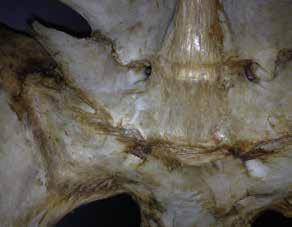
3 minute read
ORTHOPEDICS
Assessing Back Pain Can Be a Pain in the Rear
By Marie Rosenthal, MS
Although lower back pain is not typically thought of as a primary cause of lameness in a horse, it can be a source of pain that can affect performance, especially for horses doing barrel racing or dressage, according to Philippe H. Benoit, DVM, MS, DACVSMR, of Cardiff, Calif.
And it is kind of a pain in the rear for veterinarians because a precise diagnose can be difficult to ascertain, he said. Typically, lower back pain and discomfort have been considered as a compensatory issue caused from hind limb lameness, but issues related to the back and pelvis can be the primary source of the problem.
The history doesn’t always help either, because clients often complain that the horse just isn’t “working right.” And the physical examination and flexion during the examinations can be “normal.” It is not unusual to hear the referring veterinarian tell you: “I know this horse is sound,” Dr. Benoit said, “but he does not perform well.”
Often, the complaint is a lack of scope, defect of push or poor arc in flight. And there are behavior issues that signal pain. The horse is difficult to ride, resists work, is aggressive or has a bad attitude. And although the rider’s observations are important, “the vet evaluation is always a bit different than the rider’s assessment,” he said.
These complaints could very well be a back issue, rather than a hind limb or behavior problem.
As with any other issue, a thorough clinical examination is essential and should include full observation and clinical physical palpation, as well as testing and imaging.
It can be useful to watch videos of the horse’s performance or training before starting the examination, Dr. Benoit said. Watch them in slow motion, he suggested, and look at the position of the neck and the back, as well as withers elevation and lumbar extension. The horse will often modify its jumping style, maybe leaning a little sideways or off center when sore.
The examination should begin with palpation of the neck, withers, thoracic spine and lumbar area, with a focus on the caudal aspect of the back, starting with a superficial palpation and then gradually a deeper palpation.

Video, especially viewed in slow motion, can be a great tool to assess the animal's form during work.
Courtesy of the Dr. P. Benoit

Video, especially viewed in slow motion, can be a great tool to assess the animal's form during work.
Courtesy of the Dr. P. Benoit
Look at the conformation and posture of the hind limbs, the shape mass and symmetry of the muscles, joint distention, soft-tissue swelling and weightbearing abnormalities. “Although not usually done during a lameness examination, rectal palpation can provide a lot of information about back and pelvis issues,” Dr. Benoit added. It allows one to palpate the 3. caudal lumbar area, psoas muscles, pelvic bones and other structures that cannot be reached any other way, as well as castration scar tissue, ovary glands and inguinal rings. These structures might be interfering and contributing to back pain.
Observing the horse in a circle on hard and soft surfaces at a walk, canter and trot are just as important as when assessing lameness, but again, remember that issues might be subtle. Look at the position of the head and neck, watch for toes dragging on the ground, he suggested.
There are tests, such as the surcingle test—which is placed on the horse and tightened—that can enhance a defect of motion or gait asymmetry. Under-saddle evaluation is also important, Dr. Benoit said.

SI Ligt Ventral
Courtesy of the Dr. P. Benoit

Watch the head and neck during work.
Courtesy of the Dr. P. Benoit
Mobilization can help determine range-of-motion issues affecting various segments of the lower back and pelvis.
Imaging should be among the last things done during the evaluation, Dr. Benoit said. Too often, imaging is done early and that becomes the focus of the rest of the examination, rather than the examination directing what imaging is done. "You can get too much information about nothing, and you don’t know what to do next,” he said. “The thorough exam starts with localizing the back pain.”
Radiographs, ultrasonography and bone scans can all be helpful depending on the differential, according to Dr. Benoit.
Depending on the issue, Dr. Benoit tends to treat these problems with injections of medications and regenerative products as well as complementary treatments, such as massage, physiotherapy, shockwave treatments, chiropractic or acupuncture.
Just as humans no longer rest typically for low back pain, stall rest for horses is not normally considered for lower back pain, except for traumatic injury, such as fracture.
Back and pelvic pain can be a reason for mild discomfort, but without proper assessment and management, it can progress to poor performance, intense pain and become a chronic issue for the horse.






